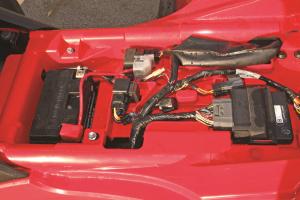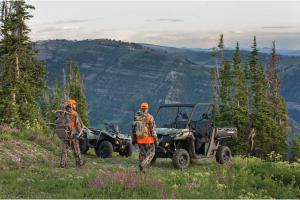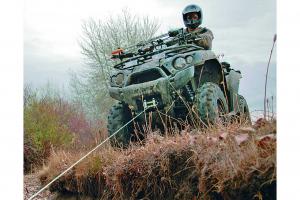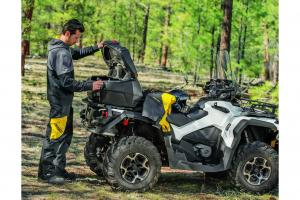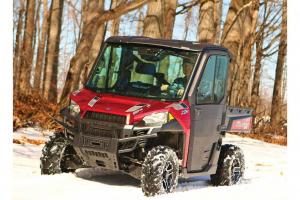For Chasing Deer Or Drifts, A Few Simple Tools Can Make All The Difference
Written By:
Staff
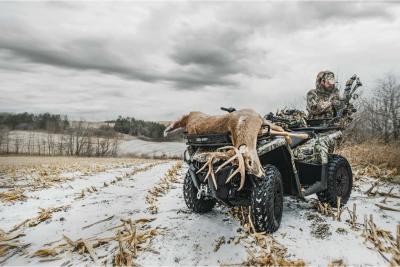 The great thing about all-terrain vehicles is, well, they’re all-terrain vehicles. While motorcycle and Jet Ski riders roll to a stop when the weather turns nasty, we grab a different set of gear, prep our machine for Mother Nature’s worst, and head back out to the deer blind and drifts! Before you can put a head mount on the wall, though, there are a few things you need to do for yourself and your machine to prepare for any winter expedition. We’ll give you our tips.
The great thing about all-terrain vehicles is, well, they’re all-terrain vehicles. While motorcycle and Jet Ski riders roll to a stop when the weather turns nasty, we grab a different set of gear, prep our machine for Mother Nature’s worst, and head back out to the deer blind and drifts! Before you can put a head mount on the wall, though, there are a few things you need to do for yourself and your machine to prepare for any winter expedition. We’ll give you our tips.PART 1 - PROTECTION for YOU
1:YOU MUST BLOCK THE WIND – BOOTS, UNDER ARMOR and RUBBER GLOVES
If your hands or body are exposed to the wind, you’re in big trouble, and dry, breathable, wind blocking fabrics are the name of the game. UNDER ARMOR style shirts are excellent as a base layer because they not only keep you warm, but they don’t trap moisture. There is a reason NFL players in Green Bay own several sets. For an outer layer, while off-road jackets are great because they allow complete movement and dirt brushes off easily, when the weather really gets nasty, we’ll either wear a snowmobile jacket, or a good quality hunting jacket that will keep us warm and comfortable when sitting all day in the deer blind. Look for a jacket with an extended neck that can be zipped up as well.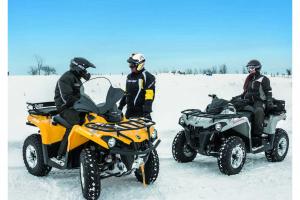

Keeping your feet and hands warm and dry is critical. More than a few hunters have never returned to camp because of frozen feet. Snowmobile boots are a great choice, but pick a set with an aggressive tread pattern for good grip on the foot pegs or floorboards which often get coated in snow and ice. Many hunting boots feature similar cold stopping materials as well. You’ve spent big bucks on your rifle, premium load ammunition, and a scope with optics that would make NASA envious. Don’t skimp on the boots or gloves! One trick we’ve learned is to wear a set of thin rubber gloves under our riding gloves. The rubber blocks the wind and water, making a huge difference in keeping your hands warm. Heated gloves or grips are a great solution as well.
2:HEAD GEAR – HAT and HELMET
It’s not always stylish to wear a helmet on your drive to the deer stand, but you still need to be protected. To keep our nugget and neck warm, we slip on a baklava for excellent coverage to our face, neck, and head, then slip on our helmet. One trick we use is to tape up any vent holes in our helmet, or better yet, use a snowmobile helmet which solves the whole problem. It’s really the way to go. Whether you are using goggles or a helmet with a shield, use an anti-fog coating and tinted lenses. The tinted lenses make it much easier to see changes in snow. A heated shield even prevents fogging!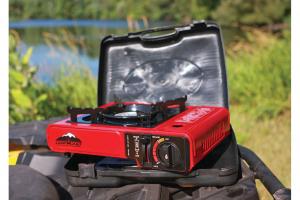

3:PREPARE for THE WORST – AN EMERGENCY CHECKLIST
Nobody ever had a successful season if they didn’t get back, and there are some things you want to own, but never hope you need. It’s really just like life insurance, only rather than calling Flo, you’ll be happy to have this stuff with you. Since hunting is pretty much an individual sport, you’re probably the only one you can count on and your own instincts, skills, and ingenuity will make all the difference. All of the items below can easily be packed into a storage box on an ATV, and a Side x Side usually has plenty of on-board storage built in. This stuff can be your best hunting buddy!
- A basic first aid kit
- Your phone – We would love to leave the darn thing at home, but it can be a rescue tool.
- Rope and Tie Downs (Parachute cord works great)
- A lighter or waterproof matches (You can make them waterproof by coating them in nail polish.)
- A GPS and map. Be familiar with both, and check the batteries first!
- Water and snacks. Chocolate bars provide high energy in a pinch.
- A flashlight and knife. Be sure to check the batteries before the season starts.
- Hand wipes for when you’re done cleaning any game. The same rubber gloves you wear under your riding gloves work great and they take up almost no storage space.
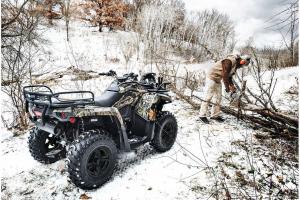 A tire repair kit
A tire repair kit- A small tarp that can double as a shelter in the event of an accident or bad weather
- A saw or hatchet, as well as your hunting knife
Other items that can make a night (or several) out alone more survivable are:
- Fire tinder
- A different pair of boots should yours get wet
- A second pair of socks
- Rain gear
- A small stove. We love our little stove from CAMP CHEF. It’s perfect for warming up a quick meal and it comes in a durable carrying case much like a cordless drill. It’s also easy to pack.
Regardless of whether you are exploring a new area, or trying to bag a big buck, you need to be prepared. It’s important in good weather, but when Mother Nature’s worst hits, it is absolutely critical to have a survival plan and a few simple tools can make all the difference.
PART 2 - WINTER MACHINE PREP
1:BATTERY – THE WEAK LINK
Thanks to much tighter lead restrictions, lead-acid batteries don’t hold a charge nearly as well as they did a decade ago, but there are excellent alternatives.
The Shorai Lithium-Ion battery is designed to be longer lasting, and to provide greater cranking power than the OEM battery. While some Li-Ion replacement batteries arrange the cells like they would for a cordless power tool, Shorai spaces their cells to allow for thermal expansion and vibration resistance.
Gel batteries are also an excellent solution, and we’ve had great luck with a Gel battery in our Suzuki for four years. It always starts strong, even in winter when we use it to push a snow plow. The advantage of Gel is longer life, higher cranking amps, and the ability to hold a charge for long periods of time, even in cold weather. However, they can be twice the price. In our experience, though, we’re glad we laid down our cash and have never needed to change the battery since.
Hunting season often means cranking over a cold engine and powering lights, a winch or other accessory items; so the last thing you need far from camp is a dead battery. Make sure your machine’s battery holds a good charge and cranks the engine over quickly.
2:FUEL – KEEP OUT THE MOISTURE
Winter fuel blends are already weak to meet emission standards, and Ethanol blended fuels are even worse. Besides reducing mileage, thanks to 20% less available energy, ethanol has the unhappy side effect of absorbing water. That means every time you open the fuel tank and the slightest bit of snow or moisture drops in, it will eventually end up in your engine, causing it to run lean. If you’re tempted to use dry gas in your tank, use it very sparingly, and NEVER use methanol which can damage materials used in your fuel system! If you have to use dry gas, ALWAYS USE ISOPROPYL types. In some areas a few gas stations still offer 100% unblended gasoline, and if you can find one, stick with it.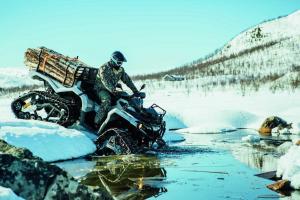

4: DRIVE LINE – CV BOOTS and TIRES
Most stock tires are designed as a compromise. They’re designed for a smooth ride, but not necessarily the best traction. For cold weather riding in mud or snow, it’s not a bad idea to
CHANGE OUT THE STOCK TIRES for a set with a more aggressive tread. We prefer a tire tread with deeper lugs with enough space between to get a good bite on the terrain or snow, but close enough together to still offer a smooth ride on frozen ground or ice. Remember that bigger tires and extremely aggressive tread patterns with deep lugs exert a tremendous amount of stress on the drive train and CV joints, and you don’t want to snap a CV joint. DON’T GO OVERBOARD ON TIRE SIZE OR TREAD! It is also important to PREVENT ICE FROM BUILDING UP around the suspension and CV joints. Ice can cause the rubber boots to twist or rip, allowing dirt and moisture to get inside. If possible, let your ATV or Side x Side warm up in the garage overnight, and check to make sure there is no ice built up around the CV joints or suspension in the morning.
5:LIGHTS - LIGHT IT UP!
Whether you hunt early mornings, late afternoons, or both, you’ll almost certainly be riding in darkness for half your trip. Make sure your machine’s lights are all working, and better yet install a couple small accessory lights from a quality manufacturer like Baja Designs. They offer excellent LED accessory lights that can brighten the woods like a full blown alien abduction.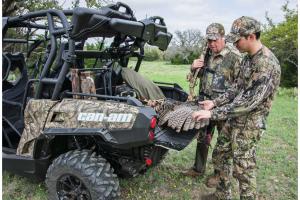

ACCESSORIES FOR THE TRAIL & HUNTING
The list of accessories for your machine is nearly endless, but there are a few go-to items that can make a big difference.
1:A GPS
For unfamiliar terrain it can mean the difference between making it back or a night in the cold. Check the batteries, learn to use it at home, and remember canyon walls can block the signal.
2:WINCH – A ROPE of LAST HOPE
Getting an ATV stuck is a problem. Getting a UTV stuck is a LOT worse. Get a winch rated for the load of your machine, and use a winch strap like those from BUBBA ROPE for looping around trees, big rocks, or whatever you are using as your anchor. Connecting the hook back onto the winch cable can seriously damage your cable. Better yet, replace the whole cable with synthetic strap from BUBBA ROPE and never worry about rust or cable kinks again. When winching, leave the engine running since winches draw a lot of power and can quickly drain any battery.
3:CABS & WINDSHIELDS
Side x Side riders can have the ultimate in weather protection with full cabs. We installed a hard cab last year from CURTIS and it went on very well. If you don’t prefer a full cab, we’ve also added soft sided cabs from SEIZMIK and they did a great job of keeping us warm and dry. Either way, you’ll be much better protected.
4:ATV HAND GUARDS and HEATED GRIPS
A simple set of hand guards can have a big impact on your comfort. Blocking the wind makes all the difference, and snowmobile riders take it one step further with heated grips. There are several brands available, but we prefer the type without a huge ceramic resistor. Whichever type you get, find a convenient location for the switch (on the left side so your hand stays on the throttle), keep the heating element away from anything critical, and use plenty of zip ties when routing the wires. Also, use a dab of silicone rubber sealant to all electrical connections to prevent shorting.
5:EXTRA STORAGE
There are always things you need to bring along, especially for winter safety and survival. Thankfully, accessory storage boxes come in about every size and shape, and they’re extremely handy! We prefer storage boxes that offer a rigid, stiff sidewall that can take some abuse, and a good seal around the opening is important as well.
INTO THE ELEMENTS
Native Americans have a saying, “Every animal knows far more than you.” Hunting them on their home turf is a challenge, but even more so when you have to battle Mother Nature too. Riding through a forest blanketed in snow is a whole new definition of beauty, and whether you are out chasing game or just out for recreation, make sure you and your machine are prepared for the adventure.


